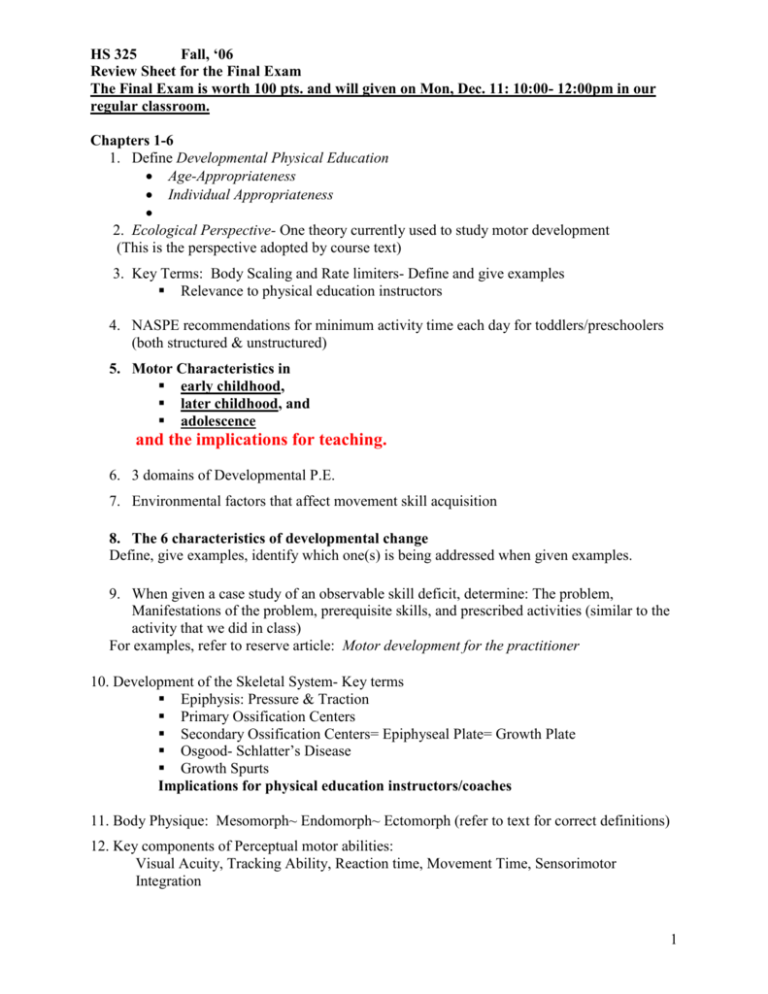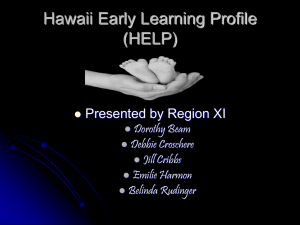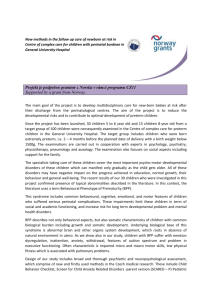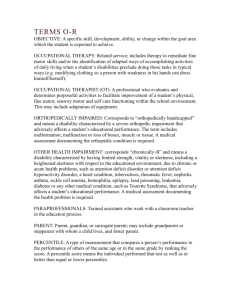HS 325 - Jan.ucc.nau.edu
advertisement

HS 325 Fall, ‘06 Review Sheet for the Final Exam The Final Exam is worth 100 pts. and will given on Mon, Dec. 11: 10:00- 12:00pm in our regular classroom. Chapters 1-6 1. Define Developmental Physical Education Age-Appropriateness Individual Appropriateness 2. Ecological Perspective- One theory currently used to study motor development (This is the perspective adopted by course text) 3. Key Terms: Body Scaling and Rate limiters- Define and give examples Relevance to physical education instructors 4. NASPE recommendations for minimum activity time each day for toddlers/preschoolers (both structured & unstructured) 5. Motor Characteristics in early childhood, later childhood, and adolescence and the implications for teaching. 6. 3 domains of Developmental P.E. 7. Environmental factors that affect movement skill acquisition 8. The 6 characteristics of developmental change Define, give examples, identify which one(s) is being addressed when given examples. 9. When given a case study of an observable skill deficit, determine: The problem, Manifestations of the problem, prerequisite skills, and prescribed activities (similar to the activity that we did in class) For examples, refer to reserve article: Motor development for the practitioner 10. Development of the Skeletal System- Key terms Epiphysis: Pressure & Traction Primary Ossification Centers Secondary Ossification Centers= Epiphyseal Plate= Growth Plate Osgood- Schlatter’s Disease Growth Spurts Implications for physical education instructors/coaches 11. Body Physique: Mesomorph~ Endomorph~ Ectomorph (refer to text for correct definitions) 12. Key components of Perceptual motor abilities: Visual Acuity, Tracking Ability, Reaction time, Movement Time, Sensorimotor Integration 1 Ch. 7 Ballistic skills- Definition and examples Types of overarm throwing Methods of gauging throwing skill Developmental changes in overarm throwing Characteristics of early, intermediate and proficient throwing Characteristics of early, intermediate and proficient punting Characteristics of early, intermediate and proficient sidearm striking Characteristics of early, intermediate and proficient overarm striking Key Terms: Differentiated Rotation, Lag, Assessment of ballistic skills Ch. 8 Manipulative skills- Definition and Examples Key Terms: Anticipation, Coincidence Anticipation, invariance, optic array Development of Coincidence Anticipation and Implications for teaching Identify individual, environmental, and task constraints that make catching success easier/difficult for children. Review the observation plan and the developmental sequence for each of the following skills: throwing, catching, kicking, punting, and sidearm striking. Have a clear understanding of the steps in the developmental sequence for each of the skills listed above. Refer to text, handouts, and class notes (ie Recognize that a child will typically catch a ball with palms up before being able to catch with palms facing each other) Ch. 9 Perceptual Motor Learning: Definition 4 components of perceptual motor learning: Provide explanation of each and give examples Give examples of activities to enhance each of the perceptual motor components Importance /benefits of developing perceptual motor skills Provide and overview (that includes the 4 steps) of the Perceptual Motor Process (refer to Sensory Motor Development handout provided in class) Ch. 14, 15 & 16 Physical Fitness 13.Compare and contrast health-related fitness and performance (skill) –related fitness 14.Identify parts of health related and skill –related fitness 15.Training principles of fitness (frequency, intensity, duration) 16.FITT Principal Examples of Camouflaged Fitness appropriate for various age/developmental levels. 17.Contributing factors to overuse injuries in children and adolescents 18.Cardiac Output: Key developmental factors 19.Endurance Training in children: Key developmental factors to consider 20.Fitness Principal if Individuality 21.Preventing overuse injuries 2 22. Describe what is meant by developmental perspective (vs. a ‘miniature adult’ perspective) When given an example, be ready to determine whether or not it is a developmentally appropriate practice. 23. 3 categories of Movement (fundamental movement skills) Chapters 11,12,13, 22. Positive Discipline and classroom Management – Key Considerations Ch. 11-12 23. Social, Cultural, and Psychosocial Constraints in Motor Development Key Terms: Self-Esteem Self-Concept and self-concept components Perceived Competence Motivation Factors that affect Affective Development IMPLICATIONS FOR TEACHING- provide examples for various age groups Teaching Styles Spectrum of Teaching Styles Benefits of using a variety of styles Important factors to consider when selecting a teaching style Ch. 13 23. Developing the Thinking Child Types of Knowledge- Examples of each. Differences between Novices and Experts Key Terms: Cognitive Map-Mapping Critical Thinking (in the motor domain) Review notes from Inside the Teen Brain (PBS Frontline Special shown in class) The relationship between knowledge base and performance- Give examples Game Stages and GLSP (Refer to notes from Nov. 6) 24. List the game stages and give examples of each (refer to Game Stages/Level of skill Proficiency handout provided in class) 25. Key indicators that the children are not ready (or are too advanced) for a particular game. 26. 5 Critical Components of Games 27. Classifying Games (refer to Game Stages/Level of skill Proficiency handout provided in class) 28. Motor assessment and Generic Levels of Skills Proficiency (GLSP) – Refer to notes provided in class. When given an example be able to identify a student’s GLSP for a specific skill. 29. Implications (of identifying GLSP) for developmental physical education 30. Factors to consider when selecting and designing games for a specific class/lesson. 31.When given a specific scenario, be able to modify a game to make it more developmentally appropriate (in all 3 domains) and maximize opportunities for students to learn, practice, and utilize skills. 3 Tests of Motor Development (Refer to notes from Nov. 8) 32. Using standardized tests to assess gross motor skills: purpose, benefits, proper protocols 33.When given the age of a child and their score on a sub-test of a TGMD-2 test, be prepared to provide examples of developmentally appropriate activities to address any motor deficit(s). . 35. What are the key Cognitive, Affective, and Motor considerations that need to be taken into account when creating/selecting activities for primary, elementary, middle school and high school students? Be prepared to give examples of how you would go about doing this as a physical educator. 36. Be prepared to complete a TGMD-2 assessment using samples provided on a DVD that will be shown during the final exam. (Similar to the practice/demonstration assessments were done in class). To be able to score each student quickly, efficiently, and accurately, you will need to be very familiar with -the criteria listed under each skill, -the scoring procedure -analyzing the data -making specific recommendations based on the assessment results This is the process that you completed for the Motor Analysis Project. SCORING PRACTICE is essential since each child will be shown (on the DVD) completing each assessment item only 2 times. 4







